Breast Augmentation increases the size of the breasts placing Breast Implants through small, discrete incisions. The best location and placement of the incisions varies depending on the type of implant, and your anatomy.
Saline Breast Implants require a shorter incision. They can be inserted empty, and inflated once inside. This allows for more variety in incision placement, and makes hiding the incisions easier.
Silicone Breast Implants come pre-filled. Since they are full when they are inserted, a slightly larger incision is required. The new, high strength (gummy bear) type of Silicone Breast Implants, require a slightly larger incision than the previous generation of silicone gel filled Breast Implants.
Breast Augmentation Before and After Photos (Augmentation Mammoplasty with Breast Implants)












































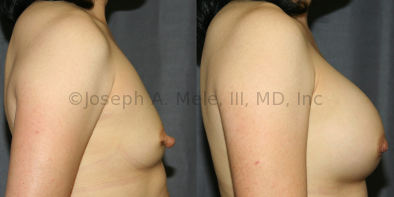
















Choosing The Best Breast Incision
In his San Francisco Bay Area Breast Augmentation practice, Dr. Joseph Mele uses multiple Breast Augmentation techniques. This gives him the ability to choose the method that can give you the best Breast Augmentation, with the safest and most predictable results. Below is general information about incision placement. While the information provided is accurate, a personalized, in-office consultation is the only way to choose the most appropriate
Breast Augmentation Video Presentation
Breast Augmentation Incisions
Several approaches exist for insertion of breast implants. The best approach for you will depend on several variables, so be certain to discuss this with your Board Certified Plastic Surgeon. Consideration is given to:
- The type of implant, saline vs. silicone, influences the size of the incision, and thus the best location.
- If you plan to breast feed after breast augmentation, an incision away from the nipple may be preferred.
- The amount of breast tissue you have before augmentation.
- Previous surgery. A preexisting scar may be an advantage or disadvantage.
- Concern with capsular contracture.
- Preexisting asymmetry may be easier to correct through a specific approach.
Below, the four most commonly used Breast Augmentation Incisions are discussed in more detail.
Periareolar Incision
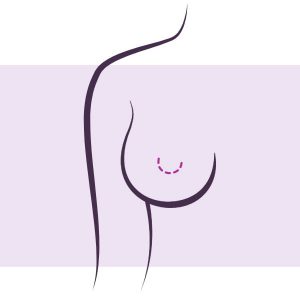 The areola is the colored skin, which surrounds the nipple. The periareolar incision is placed along the edge of the areola from about 4 to 8 o’clock. The advantage is that the scar can hide well here. Scars in this area are usually thin. If the scar ends up a little dark, it can hide in the pigmentation of the areola. If the scar is a little light, it can hide in the skin. Since we expect to see a color change along the areola, the resultant scar is usually difficult to detect.
The areola is the colored skin, which surrounds the nipple. The periareolar incision is placed along the edge of the areola from about 4 to 8 o’clock. The advantage is that the scar can hide well here. Scars in this area are usually thin. If the scar ends up a little dark, it can hide in the pigmentation of the areola. If the scar is a little light, it can hide in the skin. Since we expect to see a color change along the areola, the resultant scar is usually difficult to detect.
The periareolar approach is most often used with saline filled breast implants. The implants can be inserted through the incision empty. By inflating the implant on the inside, a smaller incision is needed on the outside.
- Advantages: Best disguised incision, and just about any implant problem can be fixed via this incision. Scar is covered by clothing.
- Disadvantages: May be too small for silicone gel breast implant placement. May cause injury to the milk ducts in the lower breast.
Inframammary Fold (IMF) Incision
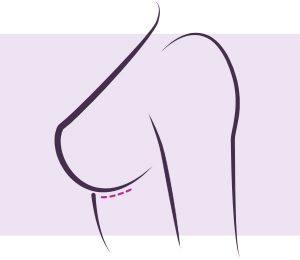 The inframammary fold (IMF)incision is made just above the crease under the breast, and is centered just lateral to a line dropped from the nipple. When the areola is too small, this is the preferred incision. The most common situation is for the placement of a silicone gel filled implant. Silicone gel filled breast implants come pre-filled, and require a larger opening for placement. Trying to force a silicone gel filled implant through too small, or too remote and incision, increases the risk of breast implant failure. Stretching the shell of the implant will cause weak spots, making the implant more likely to leak.
The inframammary fold (IMF)incision is made just above the crease under the breast, and is centered just lateral to a line dropped from the nipple. When the areola is too small, this is the preferred incision. The most common situation is for the placement of a silicone gel filled implant. Silicone gel filled breast implants come pre-filled, and require a larger opening for placement. Trying to force a silicone gel filled implant through too small, or too remote and incision, increases the risk of breast implant failure. Stretching the shell of the implant will cause weak spots, making the implant more likely to leak.
- Advantages: Any size implant can be placed via the IMF approach, and just about any implant problem can be fixed via this incision. Scar covered by minimal clothing. No injury to milk ducts.
- Disadvantages: More noticeable than the periareolar incision.
Axillary (Arm Pit) Incision
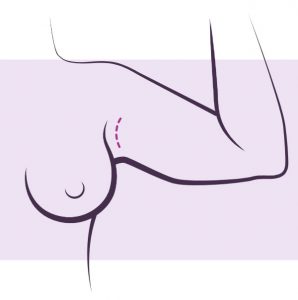 These incisions are made in the armpits. The location is discrete, but removed from the breast. Being farther away can make it more difficult to place the implants. Specialized instruments must be used to reach the lowest portion of the implant pocket. Since the bottom of the pocket cannot be felt through the axillary incision, there is a slightly increased risk of asymmetry. Silicone gel filled implants are at higher risk of injury with this incision, and the approach is not recommended.
These incisions are made in the armpits. The location is discrete, but removed from the breast. Being farther away can make it more difficult to place the implants. Specialized instruments must be used to reach the lowest portion of the implant pocket. Since the bottom of the pocket cannot be felt through the axillary incision, there is a slightly increased risk of asymmetry. Silicone gel filled implants are at higher risk of injury with this incision, and the approach is not recommended.
- Advantages: Scar in armpit.
- Disadvantages: Sensory nerve to the nipple crosses between this incision and the pocket for the implant putting it at risk. More exposed scar location. Higher risk of damage to silicone gel implants during placement. Less control over the implant pocket creation at the IMF. Cannot treat capsular contracture through this incision.
(Trans)Umbilical (TUBA) Incision
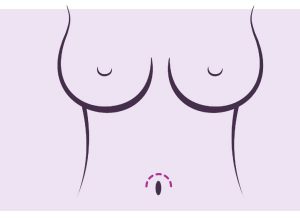 The umbilical incision is made in the upper rim of the belly button. TUBA (TransUmbilical Breast Augmentation) is performed by tunneling up from the bellybutton and into the breast. Visualization is poor at best, making this the least controlled approach. Dissection of the pocket is often done by inflating a balloon under the breast, and the implants are inserted through a long tube. Silicone gel filled implants should not be placed with this approach. The main selling point of this approach is the scar, but since the scars on the breast tend to heal well, the advantage is minimal.
The umbilical incision is made in the upper rim of the belly button. TUBA (TransUmbilical Breast Augmentation) is performed by tunneling up from the bellybutton and into the breast. Visualization is poor at best, making this the least controlled approach. Dissection of the pocket is often done by inflating a balloon under the breast, and the implants are inserted through a long tube. Silicone gel filled implants should not be placed with this approach. The main selling point of this approach is the scar, but since the scars on the breast tend to heal well, the advantage is minimal.
- Advantages: One scar instead of two.
- Disadvantages: More exposed scar location. Not suitable for silicone gel implant placement. Less control over the implant pocket creation. Cannot treat capsular contracture through this incision.